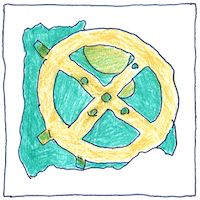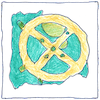Computing devices
Sumerian abacus invented in Babylonia around 2400 BCE a positional sexagesimal table for placing pebbles as counters Chinese abacus or suanpan around 200 BCE a frame with beads sliding on rods five below the beam and two above capable of bi-quinary and hexadecimal calculations Roman reckoning board a ten-by-ten grid of holes holding a single count using a peg Roman abacus a bi-quinary coded-decimal place-value tray with upper and lower grooved columns for placing counters known as calculi * Apollonius of Perga’s astrolabe around 220 BCE and later astrolabes in the Byzantine and medieval Islamic world could calculate the time of day based on the stars and planets or help you find the stars and planets based on the time of day. The Antikythera mechanism around 205 BCE with at least thirty gears was based on the Egyptian calendar and could calculate eclipses positions of the sun and moon and phases of the moon A water-powered celestial globe by Liang Lingzan and Yi Xing in the 720s computed dawn, dusk, and phases of the moon A geared mechanical astrolabe by Abū Rayhān al-Bīrūnī in 996 had eight gears, and his planisphere, a star-chart, could show the stars for any date and time, had two adjustable disks The Equatorium by Abū Ishāq Ibrāhīm al-Zarqālī in 1015 computed the positions of the planets The Torquetum by Jabir ibn Aflah (Geber) in 1100 converted horizonal, equatorial, and ecliptic measurements Ismail al-Jazari, who wrote The Book of Knowledge of Ingenious Mechanical Devices, built a large water-powered castle clock in 1206 that displayed the zodiac, orbits of the sun and moon, mannequins popping out of doors on the hours, automaton musicians that played music, and it was programmable in that seasonal length of days could be adjusted The Plate of Conjunctions by Jamshīd al-Kāshī in 1400 calculated the times of planetary conjunctions * Napier’s bones made by John Napier in 1617 to help him calculate tables of logarithms a set of multiplication tables on square-ended sticks that can be arranged on a board to multiply, divide, or find square roots William Oughtred put together two circular logarithmic rules in 1622 to create the first slide rule capable of direct multiplication and division * The machine arithmétique or Pascaline by Blaise Pascal in 1642 could add and subtract and multiply or divide by repeated addition or subtraction A non-decimal “Multiplying Instrument” by Samuel Morland in 1666 added English pounds, shillings, and pence The Stepped Reckoner by Gottfried Wilhelm Leibniz in 1672 added, subtracted, multiplied, and divided eight- to sixteen-digit decimal numbers and featured a stepped drum now called a “Leibniz wheel” The first pinwheel calculator by Giovanni Poleni in 1709 inspired successful adding machines such as the Odhner Arithmometer in 1873 The Arithmometer by Charles Xavier Thomas in 1820 used a Leibniz wheel and was the first commercially successful mechanical calculator, as though commercial success were the goal of history
Suanpan
Beads above the beam are heaven beads; beads below the beam are earth beads. Use four earth beads and one heaven bead on each rod to count in tens. Use five earth beads and two heaven beads to count in sixteens for units of weight. Cultivate thoughtlessness to perform calculations with minimal thought.
Antikythera mechanism
It used the Sothic Egyptian calendar and predicted the Olympic-game cycles, the positions of sun and moon, twenty-seven eclipses of the sun, and thirty-eight eclipses of the moon, various calendar cycles, and possibly positions of the five known planets. Egyptian names for thirteen months are transcribed in the Greek alphabet. Corinthian names for twelve lunar months are on the perimeter of the Metonic dial. It shows the path of the ecliptic through the twelve houses of the zodiac labeled by their Greek names and keyed to specific stars. It computes the Metonic cycle, the Saros cycle, the Olympiad cycle, the Callippic cycle, and the Exeligmos cycle. It tracked the precession of the elliptic. It used epicyclic gearing to track the eliptical orbit of the moon. It used a differential gear to track the phases of the moon. Nevertheless, its conception was finer than its manufacture, so that the subtleties it was designed to show would have been swamped by the crudeness of its gearing.
Napier’s bones
Here we have a set of multiplication tables arrangeable on a board to calculate products and quotients of large numbers. They are like toys but without a childish stigma, reducing multiplication to addition and division to subtraction.
Slide rule
The modern Acu-Math No. 500 has nine linear logarithmic scales, three scales on each part, and three parts, the center free to slide. The alignment of scales is assisted by a sliding transparent hairline cursor. It multiplies and divides, finds logarithms and exponentials, finds squares and square roots, cubes and cube roots, finds sines and cosines, tangents and cotangents, does unit conversions and conversion to natural logarithms. The modern Acu-Math No. 500 introduced in 1960, is obsolete.
Some tasks
It’s useless to claim special abilities: “A machine could never do what I do.” Let’s just say that a person may take pleasure in some tasks, such as peeling garlic, chopping onions, and cooking a piece of fish.




Leibniz said, “it is beneath the dignity of excellent men to waste their time in calculation when any peasant could do the work just as accurately with the aid of a machine,” but, of course, as well as being a genius, he was a royal prig. It is beneath the dignity of any person to be forced to perform any kind of work that a machine may perform just as well or better. Fortunately, ingenious people, whether ranked high or low on the social scale, have worked hard to provide better and better machines for the betterment of humankind.
See also in The book of science:
Readings in wikipedia: